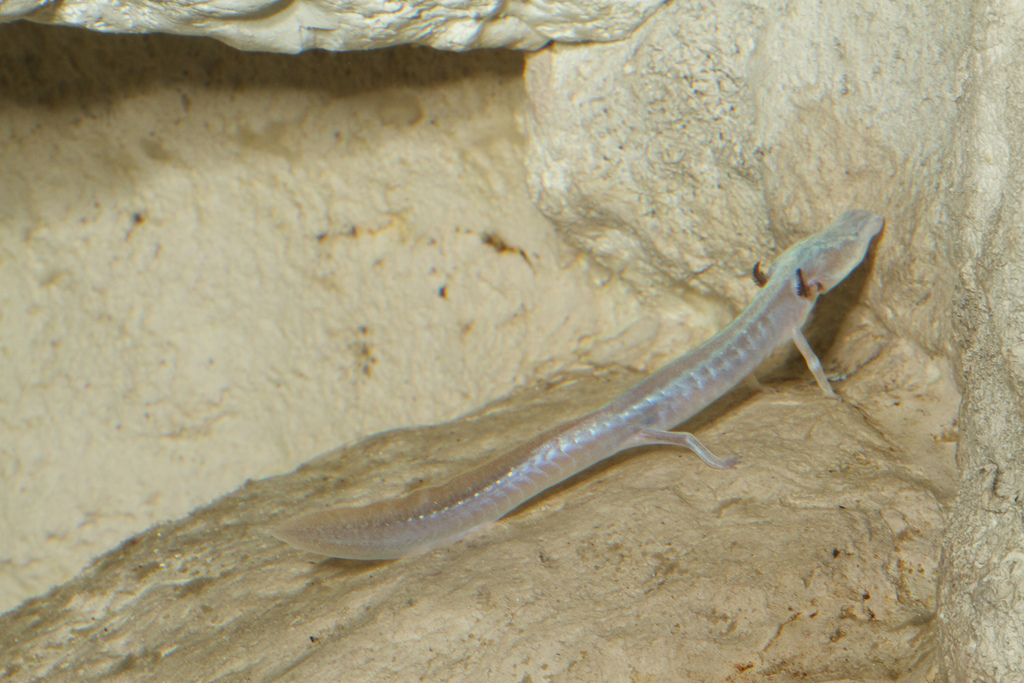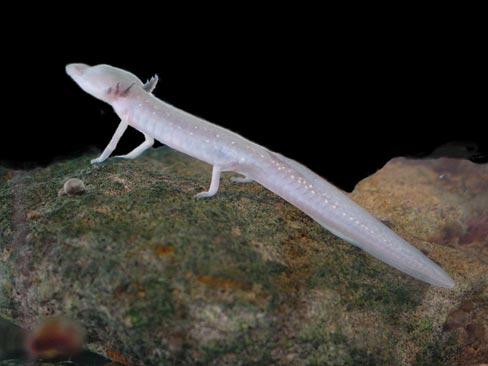Reproduction
As evidenced by its name, the Texas Blind Salamander is indeed completely blind, just like The Blind Cave Eel. This seems like it would provide a slight obstacle when it comes to mating and reproduction. One only has to consider the bright plumage and tail feathers of a male peacock in full strut or the hefty antlers of a mature bull moose, and even the extreme amount of time and care that we humans put into “dressing to impress” to see just how crucial sight is for the life process of reproduction. So, how can a miniscule, pigment-less salamander that lives deep below the ground in utter murkiness and gloom find a potential mate? The answer is both imaginative and ingenious: the use of chemical cues. Basically, each sex of salamander emits certain chemicals that are spread via the water of the aquifer that Eurycea rathbuni lives in (Springer, 2007). Due to the extreme underground nature of the habitat of the salamander, it is nearly impossible to study the effects of things such as these chemicals in its natural habitat, so therefore most of what is known comes from study of the Texas Blind Salamanders that are held in captivity (Endangered Species Bulletin, 2007).
However, it is known that because of the water-borne nature of these chemicals, any negative influences on the water quality in the underground aquifer, such as pollution, could have drastically devastating effects on the reproductive ability and population of E. rathbuni. When compared to similar setups of populations in various freshwater fish species, it is found that various disturbances to the water quality can indeed result in much more difficult and potentially non-existent communication between the organisms in the environment (Endangered Species Bulletin, 2007). This is the main reason that a group of these hearty amphibians are kept in captivity, to ensure that if some tragedy were to strike the natural habitat of E. rathbuni, there would still be viable individuals of this species left alive.
As stated before, the population that most of the data collected from the
Texas Blind salamander comes from is a captive population, meaning that the
data and life processes may or may not be exactly how they happen in nature.
It is difficult to maintain an environment that is conducive to mating for
this species, but nevertheless, data has been gathered and observations have
been made on the reproduction of E. rathbuni. One of the most surprising
characteristics of this particular salamander is the females are more active
than the males when it comes to seeking out members of the opposite sex for
mating (Epp, 2007).
 This is contrary to almost every other related species
of salamander (and with many other organisms as well) since more often than
not it is the male seeking the female.
This is contrary to almost every other related species
of salamander (and with many other organisms as well) since more often than
not it is the male seeking the female.
Another interesting mating feature of E. rathbuni is that females are only more likely to pursue a male when they are with one or more fellow females. When simply one female and one male were observed, the female often shied away from the male. However, when multiple females were present, they were much more likely to become aggressive towards each other and pursue the male (Epp, 2010). This is not entirely surprising, for mates are simply another resource subject to competition, and in the deep underground habitat where there may be a lack of resources such as food and water, competitive behavior is to be expected. It has also been observed that females are more likely than males to congregate together and that as an overall species the individual sexes are more likely to group up with like sexes (males with males/females with females).
When the Texas Blind Salamander actually reproduces, because it is an amphibian, it lays a number of eggs. These then hatch into the young salamanders and grow until they are old enough to reproduce and lay their own eggs. Eurycea rathbuni is a very unique species with some very special characteristics in its reproduction. It is crucial that more research continues to be done on these organisms so the harmful effects of pollution and other damaging factors can be stopped, ensuring the continued survival of this species.
So thats how the salamanders interect with each other, but what about with other species? Find out at the Interactions page.
